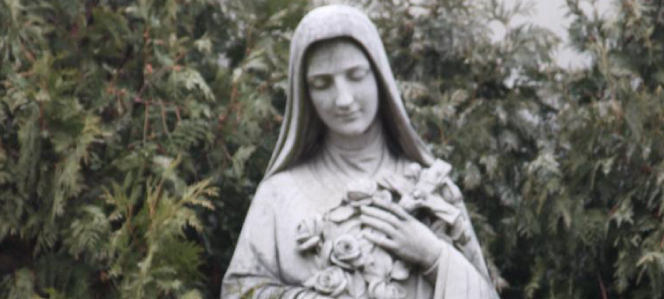Sometimes I wonder if we go about it backwards in our catechesis of young people. We tell our young people about the saints, we give them holy cards, we ask them to choose the name of a saint for confirmation – all ways, at least on one level, of hoping that they will be inspired by the saint and come to know more of Jesus and living the Christian faith. Would it not be better, first and foremost, to introduce our young people to Jesus (to truly encounter him as Lord and Savior) and then trust that over time Jesus himself will introduce our young people to his friends, the saints?
I have to admit that this is the way that I have come to know and have friendship with different saints in my own life. Through Christ I have met St. Paul, I have met St. Teresa of Avila, recently I have begun a friendship with St. Josephine Bakhita and (I have to admit) that it is only through Christ that I have developed a friendship with St. Therese.
I grew up one of four boys in East Tennessee in the 1970’s. You quickly learned how to have thick skin growing up with three brothers; as our preferred way of showing affection was either mercilessly mocking one another or sneaking a punch when the parents were not looking. My parents, may they rest in peace, were both converts to the Catholic faith. My father had a life-long struggle with alcoholism (which he lost) and my mother struggled with an alcoholic for a husband. Often, my brothers and I were on our own. My extended family is the proto-typical American family, it seems, when it comes to religion and faith – meaning we are a mix of everything (Lutheran, Evangelical, Episcopalian, Baptist, Catholic, non-practicing Catholic, and agnostic). We cover the whole spectrum. This is my experience.
What possibly could I have in common with a 24-year-old French saint who lived in the mid-to -ate 1800’s, who never left her convent once she entered, and who would break down in tears at the drop of a hat when she was a child?
Yet, I met St. Therese and I was not expecting a friendship. At the seminary I attended for my theology studies, there is a beautiful statue of St. Therese of Lisieux on this “boat-dock” area on the lake near which the seminary sits. I was in the practice of taking walks around the lake, if not every day then at least a few days each week, so every time I went for a walk I would pass by this statue. Over time, I began to notice that flowers were always left by this statue of St. Therese and I thought, “Hmmm, that’s interesting.” Then, one quarter, I took a class entitled “Spiritual Autobiography” offered by Fr. Lou Cameli and one of the books we covered was Therese’s “Story of a Soul.” I really struggled with the syrupy language of the book. It is not my style but I was taken with an incident in her childhood (which she considered her conversion moment) when she was able to let go of her own feelings and rather focus on the needs of another person (her father). She had overheard her father make a comment basically about the pampering she received at Christmas but instead of breaking down in tears (which was her wont) she let it go in a moment and celebrated Christmas with her father and family.
It was a little thing certainly but in this little thing and little moment of encounter she made the choice for love and for Christ. This choice for love in the “little moments” became her way toward discipleship and, ultimately, sanctity. I was struck by that, and by the end of that year I had made my first novena to St. Therese of Lisieux. When the Novena concluded I left some flowers by her statue overlooking the lake.
St. Therese does not impose (as some saintly figures do) and I think this is what is so attractive about her. Friendship with St. Therese is like having a sister. Her way is the little way. I was not looking for a friendship but I met her and she has been a friend and a model to me ever since.
